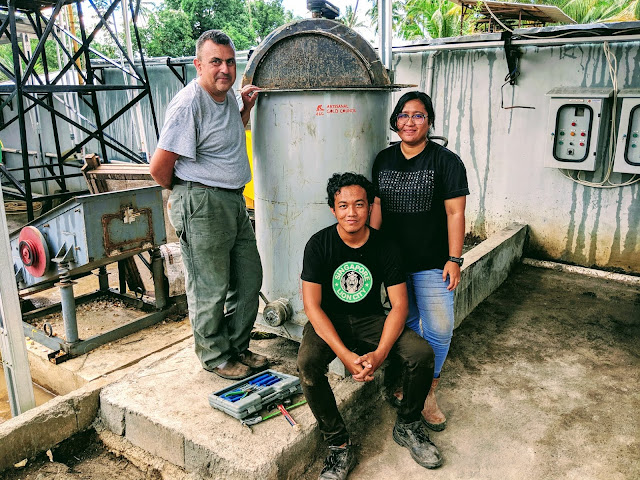Concentration of Gold Ores - a Key to Reducing Mercury Use in Artisanal and Small Scale Gold Mining
In artisanal gold mining, mercury is essentially used to concentrate the gold. It does this by bonding with the gold to form a heavy amalgam that is then easily separated from the other minerals. It follows therefore, that if mercury is used as a mechanism of concentration, producing concentrates of gold ores through other means can enable reduction or even elimination of mercury use. In other words, a good process of concentration can replace mercury and lead to big environmental and health improvements.
Concentrating gold ores before applying mercury greatly reduces the mass of material that comes into contact with mercury. This reduces the amount of material that becomes contaminated and also the amount of mercury that is required to be applied. And of course, if concentration is done with sufficient sophistication and knowledge, mercury is not needed at all.
As an important first step along the way to eliminating mercury, concentrating avoids a worst practice called whole-ore-amalgamation, where mercury is brought into contact with 100% or the ore and losses of mercury to the environment can be very high - as high as 50 parts mercury for every part gold produced (more often ranging from 20:1 to 4:1). Simple concentration methods reduce the amount of mercury required for amalgamation to roughly 1 part mercury per 1 part of gold recovered. A vast improvement. Better yet, almost all of the mercury that is applied to a good concentrate ends up in the gold-mercury amalgam and if this mercury is recycled, for example by using a retort, losses can be further decreased by an additional 95%. Operating in this way, only 1 part mercury is used for each 20 parts of gold produced.
That is hundreds of times less mercury used and lost to the environment
Common methods of concentration that are, to a variable degree, accessible to artisanal and small scale gold miners are: panning, magnets, sluicing, spirals, vortexes, centrifuges, shaking tables, and flotation - in increasing order of complexity and cost.
Choosing a technology to produce a concentrate depends on the type of ore, access to capital, and having the knowledge and organisational skills with which to acquire and operate the equipment. Access to capital and expertise is often affected by legal status – with illegal or informal status being a significant barrier for miners to acquire and operate better equipment, and by extension a barrier to eliminate the use of mercury.
There is no doubt that helping artisanal miners gain access to the equipment and knowledge required to adequately concentrate their gold ores will help them reduce and ultimately eliminate the use of mercury. Technically speaking, replacing mercury with other processes of concentration can certainly be done. It is in fact, exactly what the large scale mining sector has done over the last decades.
They used to use mercury and now they don't - and they get more gold without it
With some innovation, finance, and most importantly, some political will, the same can be true for artisanal gold miners.



Hi Kevin,
ReplyDeleteThe fact that ASM do whole ore amalgamation has also to do with particle size. They usually think that performing whole-ore amalgamation will give them better chances to catch all the gold particles, even the fine ones. They know that poor concentration techniques lead to the loss of the fine particles.
But as you know, mercury will not help for the fine gold because of flotation problems for instance. It also depends on the particle size spectrum of each particular ore and method to process it. So the ASM should have accessibility to simple particle size evaluation of their ore, in order to adopt the best available techniques. They also would gain in being able to test alternatives.
In a ASM support program in Senegal, we have setup such a simple and cheap test as a pilot measure. The problem is that the mining lab is about 800km away from the mining sites. Another bottleneck to better techniques..
Coatings of iron and manganese oxides can also reduce the efficiency of amalgamation especially in alluvial mining. Illustrations of this can be seen in the photomicrograph section of www.cleangold.com. The problem you note of determining size range is also something that can easily be done in the field. Handling gold as small as 2500 mesh is a skill that becomes much easier when using a concentration technique such as cleangold. Final recovery of a pure product, regardless of particle size and without the need for mercury or field smelting is the hallmark of this method
DeleteNice information about gold ores.gold ores will help them reduce and ultimately eliminate the use of mercury.
ReplyDeleteUS Gold Bureau
Do they know about the "Popandson Fine Gold Recovery Sluice" ? it is a simple Sluice that consists of three sizes of expanded metal 1",1/2" and 3/16" covering a "Miners Moss" mat . Those who used it in North America or Mongolia are very well satisfied and they don't need to use mercury or such harmful substances to help in recovering of fine Gold particles down to -300 mesh !.
ReplyDeleteHere's a thought for fine gold- a blue-bowl setup incorporating frothing to seperate the fines over the top. i.e. enough flow and detergent(xanthates and caustics) in a slight overflow situation. Collecting both the bowl concentrates and froth-over concentrates. Worth a crack I reckon. Anoymous from Western NSW.
ReplyDeleteBorax is a flux, an additive to smelt metals already concentrated. Borax doe not catch gold so no way to be a replacement of mercury. Better improve gold recovery systems.
ReplyDeleteNice read WNY Gold
ReplyDeletenice post..
ReplyDeleteAbacus institute Training Class in Chennai
Vedic Maths Classes in Chennai
Abacus Training Class in Chennai